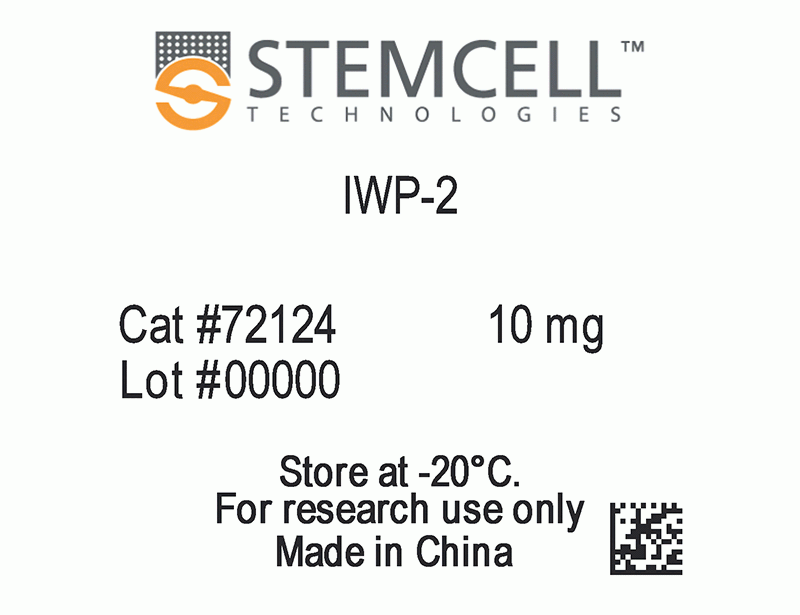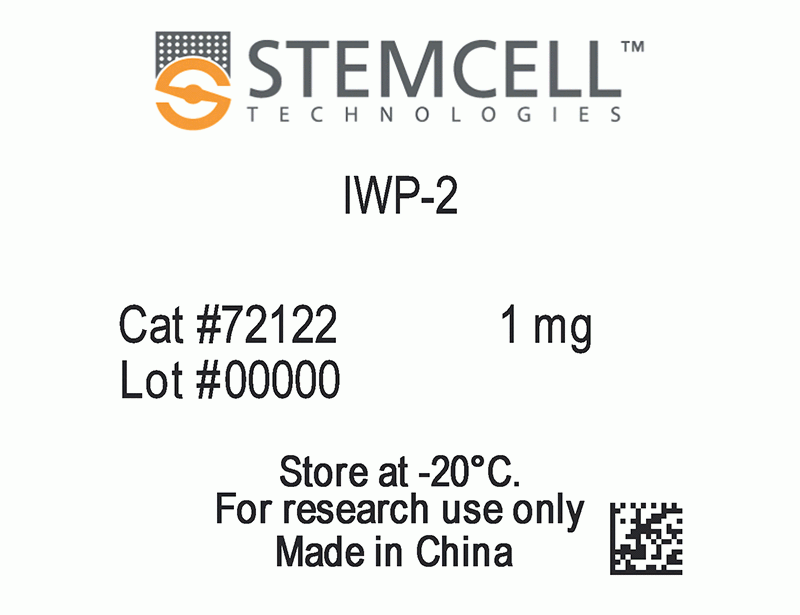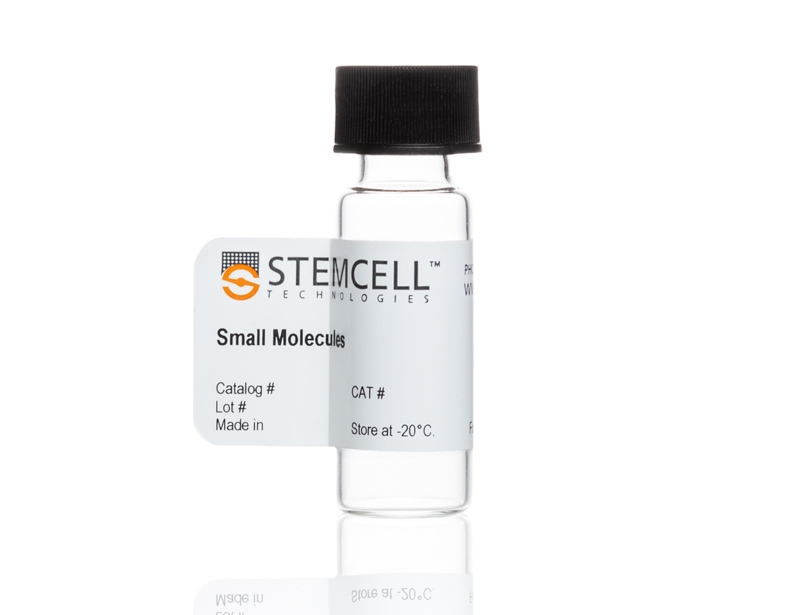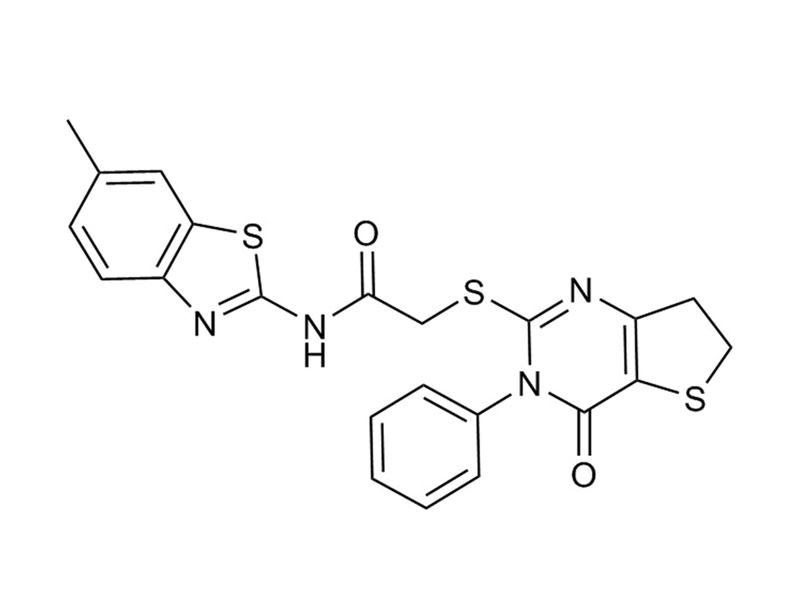IWP-2
WNT pathway inhibitor; Inhibits Porcupine
概要
IWP-2 inhibits the WNT pathway (IC₅₀ = 27 nM) at the level of the pathway activator Porcupine. Porcupine is a membrane-bound acyltransferase that palmitoylates WNT proteins, which leads to WNT secretion and signaling capability. (Chen et al., Willert et al.)
DIFFERENTIATION
· Suppresses self-renewal of mouse embryonic stem (ES) cells and supports their conversion to epiblast-like stem cells (ten Berge et al.).
· Inhibits maintenance and proliferation of mouse Lgr5+ intestinal and cochlear epithelial stem cells, demonstrating the importance of WNT signaling in these processes (Chai et al., Farin et al.).
· Promotes cardiomyocyte differentiation from human pluripotent stem cells (Lian et al., Minami et al.).
DIFFERENTIATION
· Suppresses self-renewal of mouse embryonic stem (ES) cells and supports their conversion to epiblast-like stem cells (ten Berge et al.).
· Inhibits maintenance and proliferation of mouse Lgr5+ intestinal and cochlear epithelial stem cells, demonstrating the importance of WNT signaling in these processes (Chai et al., Farin et al.).
· Promotes cardiomyocyte differentiation from human pluripotent stem cells (Lian et al., Minami et al.).
Alternative Names
Inhibitor of WNT Production-2
Cell Type
Cardiomyocytes, PSC-Derived, Intestinal Cells, Pluripotent Stem Cells
Species
Human, Mouse, Rat, Non-Human Primate, Other
Application
Differentiation
Area of Interest
Epithelial Cell Biology, Stem Cell Biology
CAS Number
686770-61-6
Chemical Formula
C₂₂H₁₈N₄O₂S₃
Molecular Weight
466.6 g/mol
Purity
≥ 95%
Pathway
WNT
Target
Porcupine
技术资料
| Document Type | 产品名称 | Catalog # | Lot # | 语言 |
|---|---|---|---|---|
| Product Information Sheet | IWP-2 | 72122, 72124 | All | English |
| Safety Data Sheet | IWP-2 | 72122, 72124 | All | English |
数据及文献
Publications (7)
Nature protocols 2013 JAN
Directed cardiomyocyte differentiation from human pluripotent stem cells by modulating Wnt/β-catenin signaling under fully defined conditions.
Abstract
Abstract
The protocol described here efficiently directs human pluripotent stem cells (hPSCs) to functional cardiomyocytes in a completely defined, growth factor- and serum-free system by temporal modulation of regulators of canonical Wnt signaling. Appropriate temporal application of a glycogen synthase kinase 3 (GSK3) inhibitor combined with the expression of β-catenin shRNA or a chemical Wnt inhibitor is sufficient to produce a high yield (0.8-1.3 million cardiomyocytes per cm(2)) of virtually pure (80-98%) functional cardiomyocytes in 14 d from multiple hPSC lines without cell sorting or selection. Qualitative (immunostaining) and quantitative (flow cytometry) characterization of differentiated cells is described to assess the expression of cardiac transcription factors and myofilament proteins. Flow cytometry of BrdU incorporation or Ki67 expression in conjunction with cardiac sarcomere myosin protein expression can be used to determine the proliferative capacity of hPSC-derived cardiomyocytes. Functional human cardiomyocytes differentiated via these protocols may constitute a potential cell source for heart disease modeling, drug screening and cell-based therapeutic applications.
Cell reports 2012 NOV
A small molecule that promotes cardiac differentiation of human pluripotent stem cells under defined, cytokine- and xeno-free conditions.
Abstract
Abstract
Human pluripotent stem cells (hPSCs), including embryonic stem cells and induced pluripotent stem cells, are potentially useful in regenerative therapies for heart disease. For medical applications, clinical-grade cardiac cells must be produced from hPSCs in a defined, cost-effective manner. Cell-based screening led to the discovery of KY02111, a small molecule that promotes differentiation of hPSCs to cardiomyocytes. Although the direct target of KY02111 remains unknown, results of the present study suggest that KY02111 promotes differentiation by inhibiting WNT signaling in hPSCs but in a manner that is distinct from that of previously studied WNT inhibitors. Combined use of KY02111 and WNT signaling modulators produced robust cardiac differentiation of hPSCs in a xeno-free, defined medium, devoid of serum and any kind of recombinant cytokines and hormones, such as BMP4, Activin A, or insulin. The methodology has potential as a means for the practical production of human cardiomyocytes for regeneration therapies.
Proceedings of the National Academy of Sciences of the United States of America 2012 MAY
Wnt signaling induces proliferation of sensory precursors in the postnatal mouse cochlea.
Abstract
Abstract
Inner ear hair cells are specialized sensory cells essential for auditory function. Previous studies have shown that the sensory epithelium is postmitotic, but it harbors cells that can behave as progenitor cells in vitro, including the ability to form new hair cells. Lgr5, a Wnt target gene, marks distinct supporting cell types in the neonatal cochlea. Here, we tested the hypothesis that Lgr5(+) cells are Wnt-responsive sensory precursor cells. In contrast to their quiescent in vivo behavior, Lgr5(+) cells isolated by flow cytometry from neonatal Lgr5(EGFP-CreERT2/+) mice proliferated and formed clonal colonies. After 10 d in culture, new sensory cells formed and displayed specific hair cell markers (myo7a, calretinin, parvalbumin, myo6) and stereocilia-like structures expressing F-actin and espin. In comparison with other supporting cells, Lgr5(+) cells were enriched precursors to myo7a(+) cells, most of which formed without mitotic division. Treatment with Wnt agonists increased proliferation and colony-formation capacity. Conversely, small-molecule inhibitors of Wnt signaling suppressed proliferation without compromising the myo7a(+) cells formed by direct differentiation. In vivo lineage tracing supported the idea that Lgr5(+) cells give rise to myo7a(+) hair cells in the neonatal Lgr5(EGFP-CreERT2/+) cochlea. In addition, overexpression of β-catenin initiated proliferation and led to transient expansion of Lgr5(+) cells within the cochlear sensory epithelium. These results suggest that Lgr5 marks sensory precursors and that Wnt signaling can promote their proliferation and provide mechanistic insights into Wnt-responsive progenitor cells during sensory organ development.
Gastroenterology 2012 DEC
Redundant sources of Wnt regulate intestinal stem cells and promote formation of Paneth cells.
Abstract
Abstract
BACKGROUND & AIMS Wnt signaling regulates multiple aspects of intestinal physiology, including stem cell maintenance. Paneth cells support stem cells by secreting Wnt, but little is known about the exact sources and primary functions of individual Wnt family members. METHODS We analyzed intestinal tissues and cultured epithelial cells from adult mice with conditional deletion of Wnt3 (Vil-CreERT2;Wnt3fl/fl mice). We also analyzed intestinal tissues and cells from Atoh1 mutant mice, which lack secretory cells. RESULTS Unexpectedly, Wnt3 was dispensable for maintenance of intestinal stem cells in mice, indicating a redundancy of Wnt signals. By contrast, cultured crypt organoids required Paneth cell-derived Wnt3. Addition of exogenous Wnt, or coculture with mesenchymal cells, restored growth of Vil-CreERT2;Wnt3fl/fl crypt organoids. Intestinal organoids from Atoh1 mutant mice did not grow or form Paneth cells; addition of Wnt3 allowed growth in the absence of Paneth cells. Wnt signaling had a synergistic effect with the Lgr4/5 ligand R-spondin to induce formation of Paneth cells. Mosaic expression of Wnt3 in organoids using a retroviral vector promoted differentiation of Paneth cells in a cell-autonomous manner. CONCLUSIONS Wnt is part of a signaling loop that affects homeostasis of intestinal stem and Paneth cells in mice. Wnt3 signaling is required for growth and development of organoid cultures, whereas nonepithelial Wnt signals could provide a secondary physiological source of Wnt.
Nature cell biology 2011 SEP
Embryonic stem cells require Wnt proteins to prevent differentiation to epiblast stem cells.
Abstract
Abstract
Pluripotent stem cells exist in naive and primed states, epitomized by mouse embryonic stem cells (ESCs) and the developmentally more advanced epiblast stem cells (EpiSCs; ref. 1). In the naive state of ESCs, the genome has an unusual open conformation and possesses a minimum of repressive epigenetic marks. In contrast, EpiSCs have activated the epigenetic machinery that supports differentiation towards the embryonic cell types. The transition from naive to primed pluripotency therefore represents a pivotal event in cellular differentiation. But the signals that control this fundamental differentiation step remain unclear. We show here that paracrine and autocrine Wnt signals are essential self-renewal factors for ESCs, and are required to inhibit their differentiation into EpiSCs. Moreover, we find that Wnt proteins in combination with the cytokine LIF are sufficient to support ESC self-renewal in the absence of any undefined factors, and support the derivation of new ESC lines, including ones from non-permissive mouse strains. Our results not only demonstrate that Wnt signals regulate the naive-to-primed pluripotency transition, but also identify Wnt as an essential and limiting ESC self-renewal factor.
Nature chemical biology 2009 FEB
Small molecule-mediated disruption of Wnt-dependent signaling in tissue regeneration and cancer.
Abstract
Abstract
The pervasive influence of secreted Wnt signaling proteins in tissue homeostasis and tumorigenesis has galvanized efforts to identify small molecules that target Wnt-mediated cellular responses. By screening a diverse synthetic chemical library, we have discovered two new classes of small molecules that disrupt Wnt pathway responses; whereas one class inhibits the activity of Porcupine, a membrane-bound acyltransferase that is essential to the production of Wnt proteins, the other abrogates destruction of Axin proteins, which are suppressors of Wnt/beta-catenin pathway activity. With these small molecules, we establish a chemical genetic approach for studying Wnt pathway responses and stem cell function in adult tissue. We achieve transient, reversible suppression of Wnt/beta-catenin pathway response in vivo, and we establish a mechanism-based approach to target cancerous cell growth. The signal transduction mechanisms shown here to be chemically tractable additionally contribute to Wnt-independent signal transduction pathways and thus could be broadly exploited for chemical genetics and therapeutic goals.




